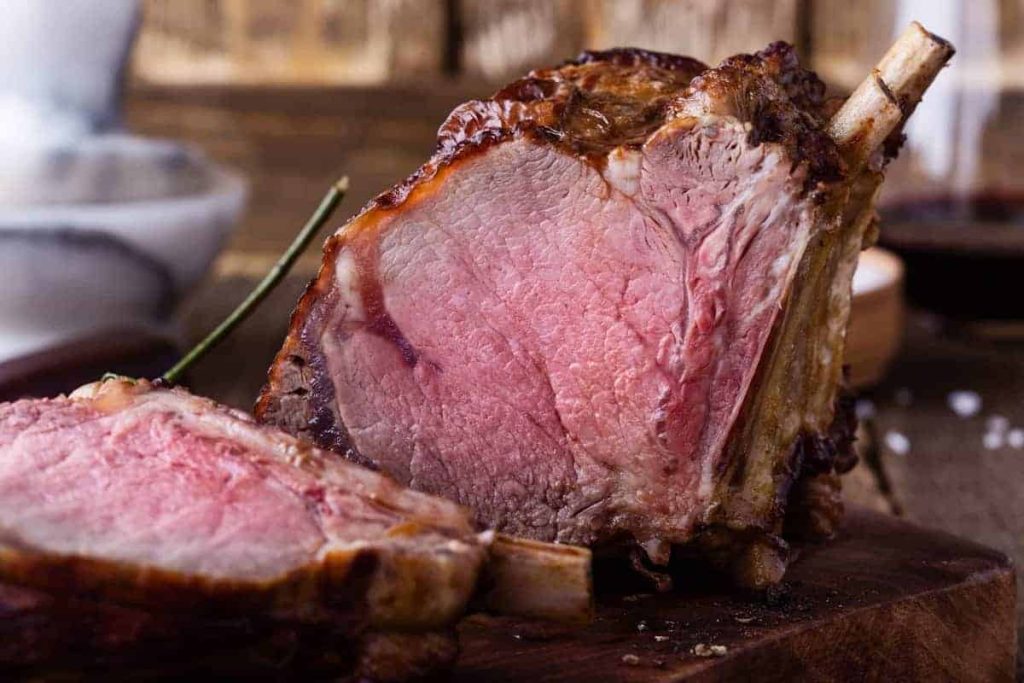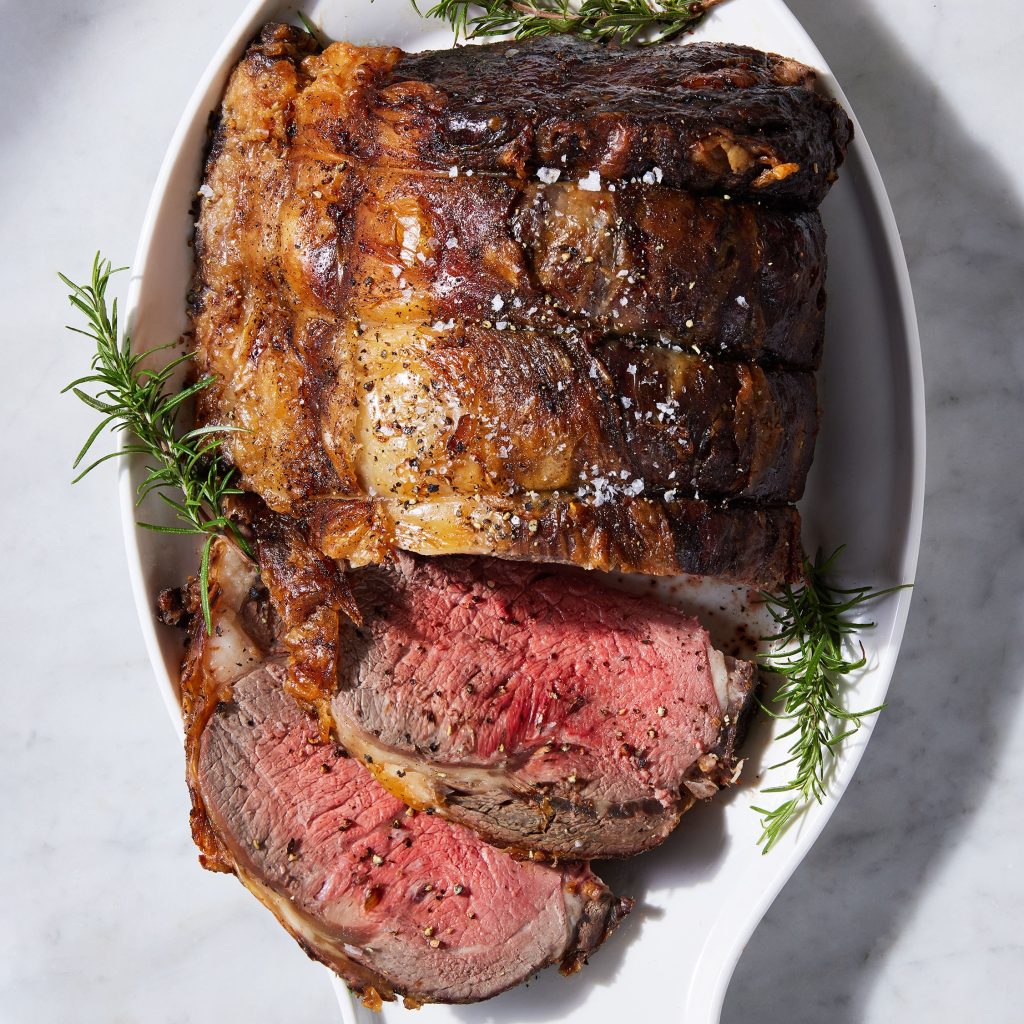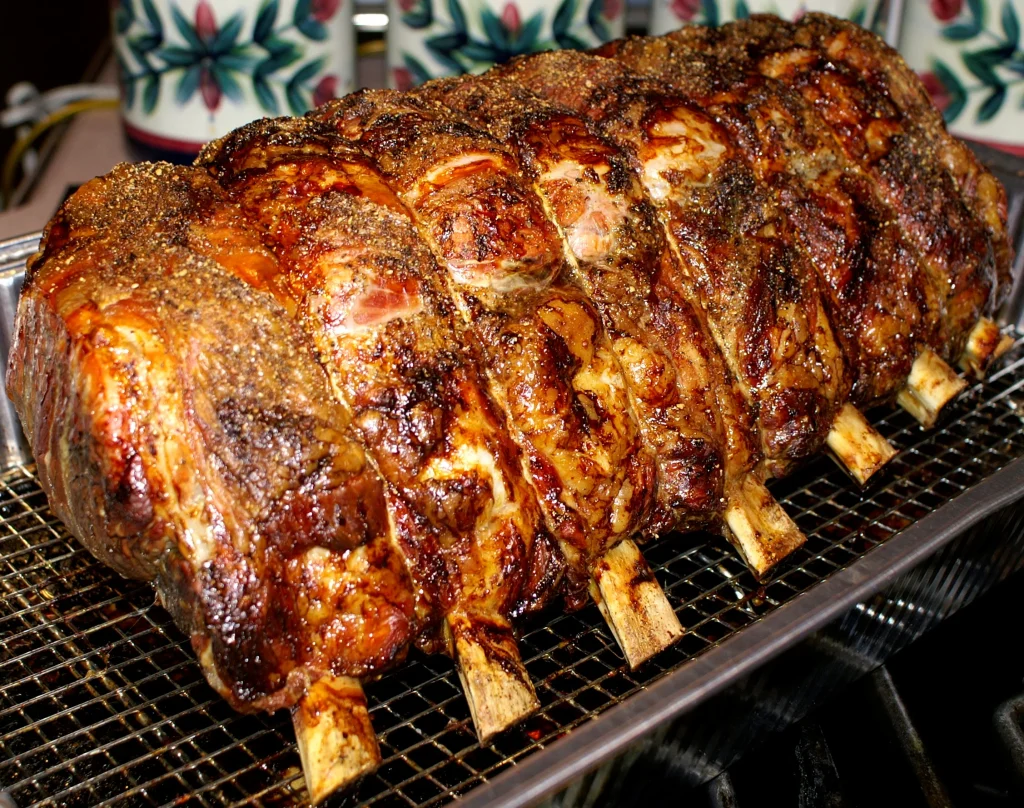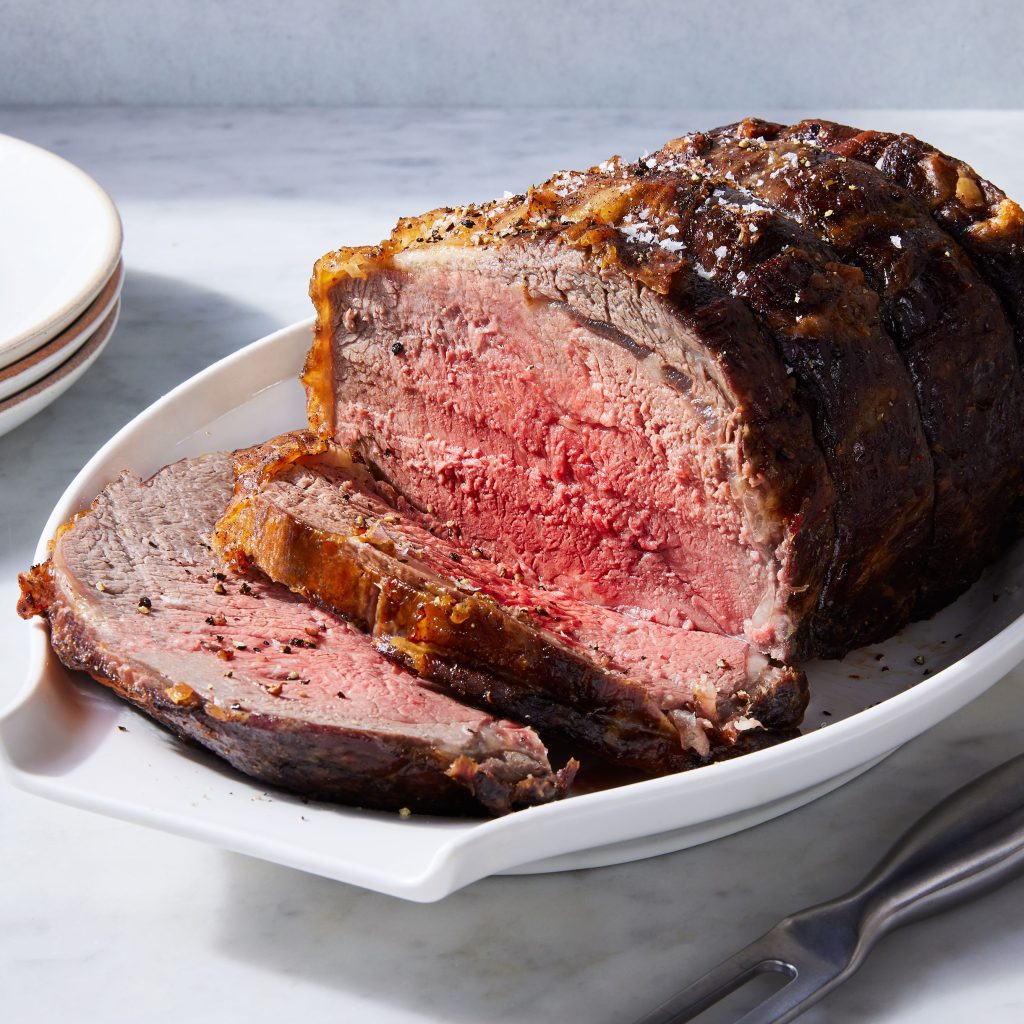Prime rib is a classic and luxurious cut of beef that is perfect for special occasions like Christmas, Easter, or a birthday party. This popular roast is best described as tender, juicy, and mouth-watering. However, cooking an 8 lb prime rib can be intimidating and challenging for many home cooks. But don’t let this roast scare you! With the right preparation, seasoning, and cooking technique, you will be able to transform an ordinary piece of meat into a succulent and delicious feast. In this article, we’ll give you tips and tricks for cooking the perfect 8 lb prime rib that will impress your guests.

Choosing the right cut and preparing an 8 lb Prime Rib
Before we dive into the actual cooking process, it’s essential to understand the different types of prime rib cuts available in the market. The most common cuts are boneless, standing bone-in, or rolled bone-in prime rib. When choosing a cut, look for meat that is evenly marbled with fat, which will enhance the flavor and tenderness of the beef.
Once you’ve selected your prime rib cut, it’s time to prepare it for cooking. First, preheat your oven to 500°F. Then, pat the prime rib with paper towels to remove excess moisture. Season the beef with salt and pepper, and let it sit at room temperature for at least 1 hour so it can come to room temperature before cooking. Additionally, you can add a layer of herbs like rosemary, thyme, or garlic to give the meat an extra boost of flavor.
After seasoning the prime rib, tie it with kitchen twine so that it retains its shape while cooking. This step is crucial because it ensures that your prime rib is cooked evenly and stays juicy and tender. Place the prime rib on a roasting pan with the fat side facing up. The fat layer acts as a natural basting agent and keeps the beef moist and flavorful.

Seasoning the Prime Rib
Seasoning is what makes a prime rib stand out from other beef roasts. If you’re wondering why this extravagant cut of meat needs seasoning, it’s because seasoning provides flavor as well as a crust on the roast. Moreover, the seasoning helps tenderize the meat. There are a variety of seasonings you can use, but there are a few basic techniques you should consider. Keep in mind that the seasoning should not overpower the flavor of the meat, which is the star of this dish.
When it comes to seasoning your 8 lb prime rib, some of the basic techniques to consider are a dry rub, a wet marinade, or simply using salt, herbs, and pepper. A dry rub is a mixture of herbs, spices, and salt that is applied directly to the meat’s surface, creating a flavorful crust. On the other hand, wet marinades are made up of oil, vinegar, citrus juice, herbs, and spices that give the meat infusions of flavor over extended periods. Lastly, some people like to keep things simple by using salt, herbs, and pepper to create a classic flavor profile that highlights the meat’s natural flavor. Discovering the perfect combination takes some experimentation, so you might want to try various seasoning methods and find the one that suits your taste buds.
How to season an 8 lb prime rib to perfection
The perfect seasoning for an 8 lb prime rib depends on your preference, and it’s not uncommon for home cooks to have their own recipe that they swear by. However, some of the most popular recipes include a combination of salt, pepper, garlic, and herbs like rosemary or thyme. Many people believe that herbs enhance the flavor and aroma of the roast meat. A dry rub contains a combination of dry ingredients, including salt, pepper, garlic powder, paprika, and herbs. The moisture from the meat aids the dry rub in creating a paste that adds a fantastic flavor to the outside of the meat. Aside from this, some people like to include other seasonings like mustard, honey, or soy sauce to create a unique flavor profile. Whatever you choose, remember to apply the seasoning evenly to each part of the meat to get a consistent flavor.
There are several steps to take into account when seasoning an 8 lb Prime Rib. One unique idea to consider is a wet rub that includes horseradish and herbs. When preparing the rub, mix grated horseradish to softened butter with herbs like rosemary, thyme, and parsley before spreading it evenly across the prime rib. This process will add strong flavors to the meat that complement the natural taste well. Adding a little bit of citrus juice, vinegar, or Worcestershire sauce to the mix can help to tenderize the meat. Keep in mind that as the prime rib cooks above the wet rub, it will develop a flavorful crust. Thus, preparing a soft and flavorful rub will not only impact its initial taste but also increase its flavor over time.

Cooking Techniques
Another technique to consider when seasoning your 8 lb prime rib is a herb crust. A herb crust consists of a blend of fresh herbs like rosemary, thyme, garlic, and parsley, chopped finely with other dry ingredients like breadcrumbs and salt. You can spread this mixture over the top of the meat and roast it to create a flavorful outer crust. The crust will add fantastic flavor and texture to the meat, as the outer layer will be crunchy while the inside remains perfectly moist and tender.
It’s worth noting that seasoning is not only about the herbs and spices; it’s also about the salt. Salt is what enhances the flavor of the roast and is a vital component of the seasoning. Don’t be discouraged to use salt, and remember that it’s best only to use kosher or sea salt. These varieties are less likely to contain additives, making them purer and allowing the meat’s flavor to shine through. The right amount of salt is crucial to avoid an over-salted roast, and the general rule is to use one teaspoon per pound of meat.Regardless of which method you choose, remember to give yourself enough time to prepare and season the roast correctly. The seasoning can be done up to a day in advance to give the spices time to infuse the meat, letting you achieve that perfect flavor profile.
For optimal results, it’s best to season the prime rib evenly and let it rest at room temperature for an hour before roasting. This technique results in an evenly cooked and tender piece of meat. Make sure to remove the meat from the fridge about two hours before roasting to bring it to room temperature. This step ensures even cooking, as a piece of cold meat requires more time in the oven, leading to overcooking.Cover the rib roast with a generous amount of seasoning or rub, making sure to message it into the meat. Don’t forget to season the area where the bones have been removed to ensure that there’s flavor throughout the roast while cooking. Some people cover their prime rib roast with mustard to create a more robust flavor profile and help the seasoning to stick. The mustard will enhance the flavor of the meat while keeping the seasoning in place. Once you’ve seasoned the roast, place it onto a roasting pan and cover the bones with foil to prevent them from charring during cooking.

Remember to preheat the oven to 450°F or 230°C to create a robust sear. After 15 minutes, turn down the heat to 325°F or 160°C and roast the meat for about 2 hours. If you prefer a medium-rare prime rib, make sure to roast the meat until a thermometer reads 120°F or 49°C. At this point, your prime rib is ready to come out of the oven; place it onto a chopping board and cover it with foil to let it rest for about 15 minutes. The resting stage is crucial, as it allows the meat’s juices to redistribute throughout the meat, resulting in a more tender and flavorful final result.Certainly! Continuing the previous paragraph, you can also use a meat thermometer to ensure that the prime rib is cooked to your desired level of doneness. If you prefer a medium prime rib, cook it until the thermometer reads 130-135°F or 54-57°C, whereas a well-done prime rib will have an internal temperature of 145°F or 63°C. Also, remember to consider the meat’s carry-over cooking time.
This factor refers to the meat’s internal temperature continuing to rise once it’s removed from the oven, so it’s best to take it out of the oven when it’s around ten degrees shy of your preferred temperature. The meat will continue to cook and reach the desired temperature as it rests for those fifteen minutes.To serve, remove the bones and carve the prime rib into even slices, making sure each one has a perfect crust on the outside. Place a small amount of pan juices over each slice, and serve with your choice of accompaniments like horseradish sauce, buttered vegetables, or fluffy mashed potatoes. With the right seasoning and the perfect cooking techniques, you’ll have successfully prepared an 8-pound prime rib roast that will impress and satisfy everyone’s taste buds!
Cooking the Prime Rib
Preparing the prime rib for cooking
Cooking a perfect prime rib is all about choosing the right cooking technique that complements the texture and flavor of the meat. There are several methods that one can use to cook an 8 lb prime rib to perfection. Some of the popular techniques include roasting, broiling, grilling, and smoking. Each technique has its benefits and drawbacks, so it’s important to understand them before making a decision about which one to use.
When selecting a cooking technique, you want to consider the texture and flavor you want to achieve with your prime rib. This will help you decide which technique best aligns with your desired result. For a juicy and tender prime rib, roasting is the most popular cooking method. It involves cooking the meat at a low temperature over a long period. The result is a perfectly cooked prime rib with a crispy golden exterior. Other cooking techniques such as grilling and smoking are great for imparting a smoky flavor to the meat. These methods take less time than roasting and provide a nice char on the exterior of the prime rib.
Cooking the 8 lb prime rib to perfection
To choose the best cooking technique, you also need to consider the available resources and equipment you have in your kitchen. Grilling, for example, requires a grill, while roasting and broiling can be done in your oven. Smoking, on the other hand, requires specialized smokers and wood chips.
Another essential aspect to consider is the cooking time and temperature. For an 8 lb prime rib, it takes approximately two hours to cook at 325°F for medium-rare. However, cooking time and temperature can vary depending on the cooking method used, and the desired doneness. It’s essential to keep a meat thermometer handy and check the internal temperature periodically during cooking to achieve the perfect level of doneness.
With the different cooking techniques available, you can experiment with several recipes until you find the perfect one that meets your taste preference. The essential thing is to ensure that the prime rib is prepared and cooked to the highest standards to bring out the natural flavors and textures of the meat.
When cooking an 8 lb prime rib, it’s also important to let the meat rest for at least 15-20 minutes after cooking. This allows the juices to redistribute, and the meat to become much more flavorful and tender. You should also use a sharp carving knife to cut the prime rib into thin, even slices against the grain. This technique helps to keep the slices from turning out tough and stringy. Additionally, you want to ensure that the presentation of the prime rib is visually appealing by using garnishes such as herbs, and sauces to elevate its appearance.
Remember that cooking a perfect 8 lb prime rib is a delicate and intricate process that requires attention to detail and patience. It is therefore important to follow each step carefully while being mindful of cooking time, temperature, and internal temperature using a meat thermometer. By doing this, you can achieve a delicious, juicy, and tender prime rib that will impress your guests and make you feel like a master chef.
Serving the Prime Rib
In conclusion, cooking an 8 lb prime rib may seem daunting, but it is an achievable feat when you understand the different cooking techniques and follow the necessary steps. Roasting is the most popular cooking method as it results in juicy and tender prime rib, but other techniques like smoking or grilling also provide unique flavors to the meat. When preparing the prime rib, it’s important to choose the right cut, season it correctly, and let it rest after cooking. Additionally, keep a meat thermometer handy to monitor the internal temperature of the meat, and make sure to let the meat rest after cooking before slicing it, so it retains all of its juices. With these tips, you can achieve the perfect 8 lb prime rib and impress your guests with your culinary skills.
Tips on how to present and serve the perfect 8 lb prime rib
If you’re new to cooking 8 lb prime rib, don’t be afraid to practice and experiment with different techniques and seasoning combinations until you find the perfect one that works for you. Remember, cooking is an art, and it takes time and effort to discover what you like best.
You can also learn more about cooking the perfect prime rib by researching and reading recipe guides, watching videos, and attending cooking classes. This not only helps you to expand your knowledge and hone your skills but also allows you to discover new and exciting ways to cook prime rib.
With some practice, patience, and determination, you can become a pro at cooking 8 lb prime rib. So, fire up your oven, get out your favorite seasoning, and start cooking!To add more value to the blog post, it’s essential to understand the different types of prime rib and their characteristics. Knowing this information can help you make an informed decision when selecting the perfect prime rib for your meal.The different types of prime rib include bone-in prime rib, boneless rib roast, and standing rib roast. Boneless rib roast is a popular choice as it is easy to carve and has no bones. It is sometimes also known as a rolled rib roast because it is rolled and tied into a cylindrical shape. A standing rib roast, a boneless rib roast, or a bone-in prime rib with a generous amount of fat, is often considered the most flavorful cut and can be more tender. With bone-in, flavor is thought to come from the bone marrow. Boneless prime rib roasts have the benefit of being easier to carve.
When selecting your prime rib, make sure to choose a quality cut with plenty of marbling. The marbling refers to the fat within the meat, which helps to keep it juicy and flavorful. A well-marbled prime rib will also have a rich taste and an excellent texture once cooked.
Another important consideration is the aging process of the prime rib. Dry-aged prime rib is often considered the gold standard as it undergoes a controlled aging process in a refrigerated environment. This process helps to break down the muscle fibers and tenderizes the meat while enhancing its natural flavor. Wet-aged prime rib may not have the same level of tenderness and flavor as the dry-aged variety due to the process.
Taking the time to understand the different types of prime rib and how they are aged can help you make an informed decision when purchasing your meat, and can ultimately lead to a more delicious and satisfying dining experience.

Hello there! My name is Tristram Ortega and I am a professional chef with a passion for cooking. I work at a top-rated restaurant where I create delicious dishes every day, and I’m excited to share my tips and techniques with you. Through this blog, I share my favorite recipes, cooking hacks, and insights into the world of professional cooking. So let’s get cooking together!